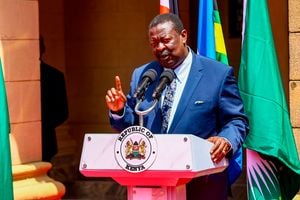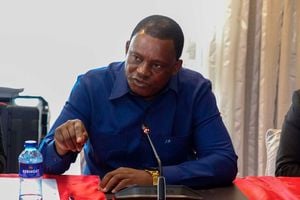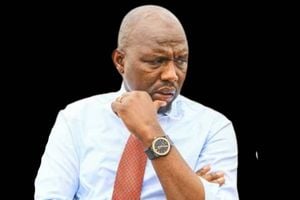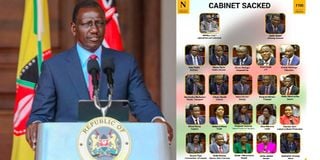
President William Ruto (left) sacked his entire Cabinet on July 11, 2024.
President William Ruto sacked his entire Cabinet on Thursday, July 11, in what was largely a matter of when not if after weeks of sustained youth-led protests and major goofs by some of his ministers.
Some of the Cabinet Secretaries had lost public confidence over corruption allegations and poor performance, triggering a demand by youth that the President dissolve, and not reshuffle, his Cabinet. The protesters’ push had earlier resulted in the unprecedented withdrawal of the Finance Bill, 2024, which was a clear vote of no confidence against the Kenya Kwanza administration.
In a televised announcement at State House, President Ruto said he made the decision to fire all the CSs after a holistic appraisal of their performance. He had in August last year, during the signing of performance contracts by the ministers, admitted that some of them were incompetent. He said then that some ministers and Permanent Secretaries were clueless about their mandates.
For close to two years that they have been in office, there has been a growing perception that some of the officials are arrogant, entitled and not averse to displaying conspicuous consumption through their dressing and vehicles — and often contributing huge amounts in harambees.
The display of opulence has been at the heart of the rage by the youthful demonstrators, who for the first time in the country’s history managed to invade Parliament in protests against additional taxes.
President Ruto rode to power on lofty promises of creating jobs for millions of unemployed youths, prioritising the needs of low-income earners and to bring down the cost of living. He campaigned on the platform of a bottom-up economic model that was designed to economically uplift the downtrodden. But there is a feeling that his administration has failed to deliver on its promises.
Dismiss
“Upon reflection, listening keenly to what the people of Kenya have said and after a holistic appraisal of the performance of my Cabinet and its achievements and challenges, I have…decided to dismiss with immediate effect all the Cabinet Secretaries and the Attorney-General from the Cabinet of the Republic of Kenya except the Prime Cabinet Secretary and Cabinet Secretary for Foreign and Diaspora Affairs,” said President Ruto.
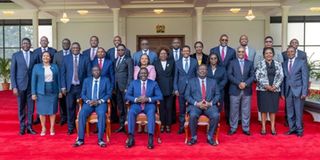
President William Ruto with members of his cabinet at State House, Nairobi.
Only Prime Cabinet Secretary Musalia Mudavadi, who also serves as the Cabinet Secretary for Foreign and Diaspora Affairs, was spared. Deputy President Rigathi Gachagua was also not affected by the sweeping changes that seek to assuage widespread disaffection among the youth who have taken the country hostage with mass protests.
In the meantime, the President said, “during this process, the operations of government will continue uninterrupted under the guidance of Principal Secretaries and other relevant officials.”
The sacking of the Cabinet has set in motion another delicate balancing act for the President in the wake of his falling-out with his deputy, Mr Rigathi Gachagua even as the shadow of ODM leader Raila Odinga looms large in the planned reconstitution of the Cabinet. Dr Ruto, for the second time, said he would be reaching out to other political players to come up with a new Cabinet that will steer the country to economic growth. He has since closed ranks with Mr Odinga in pushing for a national dialogue under the proposed National Multi-Sectoral Forum that will be held for six days, starting Monday.
“I will immediately engage in extensive consultations across different sectors and political formations, with the aim of setting up a broad-based government that will assist me in accelerating and expediting the necessary, urgent and irreversible, implementation of radical programmes to deal with the burden of debt, raising domestic resources, expanding job opportunities, eliminate wastage and unnecessary duplication of a multiplicity of government agencies and slay the dragon of corruption consequently making the government lean, inexpensive, effective and efficient,” said the President.
Although it is the prerogative of the President to appoint his Cabinet, he does this through consultation with his deputy, whom they were elected on a joint ticket. But with the bad blood between the two, which is now public, it is not clear if the President will engage him. Mr Gachagua was on Thursday conspicuously missing at State House when the President dissolved the Cabinet.
Ms Njeri Rugene, head of the Deputy Presidential Communication Service did not respond to our queries on why Mr Gachagua was absent and whether he was consulted before the sacking of the ministers. Some of them are said to have been appointed by the President on his recommendation.
Dr Ruto had on Tuesday indicated plans for a “broad-based political arrangement” lending credence he could be considering to co-opt Mr Odinga into his government.
The President is said to be toying with the possibility of a ‘government of national unity’ with opposition figures in his administration as part of his way out of the current political crisis triggered by the protesting youths, who have cornered him and demanded major re-organisation of his government.
Dr Ruto is said to have dangled some Cabinet slots for ODM in what could likely deepen the widening rift with his deputy. This means some of the CSs will be replaced with new faces, some from the opposition coalition.
Youthful leaders
The President is also likely to consider youthful leaders when he picks his new Cabinet.
Analysts believe reconstitution of the Cabinet could escalate the wrangles between the President and his deputy. It could also trigger a split in the opposition Azimio la Umoja One Kenya Coalition. Wiper leader Kalonzo Musyoka, DAP-K counterpart Eugene Wawalwa and Narc party leader Martha Karua have all rejected any deal with Dr Ruto.
Nyeri Governor Mutahi Kahiga, who is a close ally of Mr Gachagua has since sounded a warning against engaging Mr Odinga.
“Mr President, wake up and smell the coffee. I have listened to you, and those are outdated methods. The idea of bringing in Mr Odinga is something that Kenyans grew tired of long ago... he has been brought in too many times. This is a new era, and I know you read the Bible; new wine and old wineskins don’t mix. If we are dealing with new wine, we need a new wineskin,” said the Governor.
But Mr Odinga’s ODM has embraced the political talks. In a statement, ODM national chairman John Mbadi said the party supports the talks to address underlying issues to avoid a possible “precipice” in the country.
“…Raila Odinga always helps the country pull back from the precipice whenever we find ourselves there. There can be no doubt that as a country, we are at a crossroads and approaching a precipice.
“One of us has to be magnanimous and patriotic enough to help call the country to order,” Mr Mbadi said.
He emphasised that ODM is “a disciplined organisation that believes in order and command.”
“The party leader has spoken. I have also had a chance to meet and speak with him to explore the matter further. We are in agreement that his call is in the best interest of the country and will help address the emerging issues in a structured and coordinated manner. His proposal will ensure accountability, including timelines within which the issues agreed on must be realised,” said Mr Mbadi.
It would not be the first time Kenya is having a government of national unity, having had one in 2005 following a referendum that was lost by then President Mwai Kibaki. The country also had a grand coalition government following the deadly 2007/08 post-election violence.

